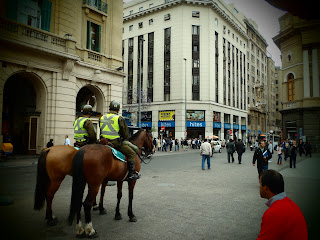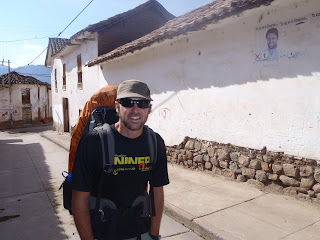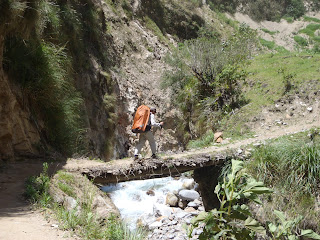Valparaiso, Chile
Dave and I spent our one year anniversary in Valparaíso, Chile, enjoying a nicely appointed bed and breakfast in the quirky city. What a TREAT to stay at Hostel Morgan and totally relax. The majority of places that we stay aren´t that great to just hang out in the room...better to be in the common areas of the hostels. Our room was beautiful, warm, and sunny with an adjacent terrace = fantastic.
Valparaíso is a colorful city that is a port town and jets straight up from the ocean. The streets and steep and windy full of beautifully colored houses, acensores, ice cream stores, empanada stands, and sleepy stray dogs. There´s a bit of a bohemian flare from the youth of the city who seem to be politically active and more counter-culture. I went to Valparaiso with my friend Natalie 5 years ago when we travelled through Chile together and enjoyed going back!
We spent 3 nights and 4 days enjoying the local Chilean food, sleeping in, and wandering the streets...finding fun nooks and crannies all over. On our actual anniversary night, we went to a beautiful restaurant called La Colombina that overlooked the harbor where you could see twinkling lights reflect off the water. We had wine and meat...perfect! It didn´t take us very long to realize how unhealthy Chileans and Argentinians eat, but the food is good, nevertheless. The plato tipico of Valparaiso is called Chorillana. It consists of a huge heap of greasy french fries, grilled onion with scrambled egg, sauteed meat pieces, chorizo sausage, with while sauce all over. Gut wrencher. We ordered one at a super typical chilean hangout restaurant as a recommendation from the waitress. WOW.
Chileans love their completos...as in the last blog post...hotdog, tomato, avocado, and heaps of condiments including the everpresent slop of mayo. Dave learned to love completos in Chile also...especially because it´s kind of fun to say and you hear it from all around when vendors have little street stands. Chileans also love their sweets, a recipe for disaster for me. Many specialize in homemade ice cream....mmmmm.
Our weather in Valparaiso was (for the most part) really nice and we had some bright, sunny days. While walking around the city, Dave and I took as many ascensores as possible. Ascensores are small carts that run up and down 45-50 degree slopes on opposite tracks. They essentially do the work for eachother. Fun though for a quick ride that costs about 20 cents.
We decided that our trajectory would change after Valparaiso. Instead of heading further south in Chile, we crossed over to Mendoza, Argentina through a beautiful mountain range and up a crazy curvy road. Mendoza is wine country in Argentina...and we took full advantage of this by doing the typical tourist activity of renting bikes and riding around the countryside and to taste the wines. We ended up finding more than just wineries, but also craft breweries, olive oil makers, etc! We had a great day of riding around in the hot sun and visiting several different wineries. Definitely exhausted after the end of the day!
We tried to go rafting out of Mendoza but the rivers were low so we decided to go out to a hotsprings on the countryside. It must have been a school holiday, because we were met by MANY middle-school aged teenagers splashing around in the water. Definitely good people watching. Outside of the hot spring complex, Dave and I experienced out first asado completo at a restaurant and nearly bursted our stomachs. WOW, the amont of food was spectacular. We were warned by some people that ordering the normal asado can sometimes contain all kinds of intestines (intentine, kidney, liver...even brain!) and blood sausage. We opted for the more subdued meat menu but still aren´t 100% opposed to trying some of the more exotic choices in a nicer restaurant.
The Spanish spoked in Chile and Argentina is SO different. The accent, slang, speed...woooo! If I´ve been having trouble, I can only imagine how Dave is thinking. I´m getting better and better and picking out words through the pronunciation, but the Chileans cut off "s" in every word and the Argentinans slur and pronounce their L´s and Y´s completely differently. Made me think how an English learner would feel if they were being talked at by a Scottish, Oregonian, Texan, Australian, Irish, English, etc and how they would discern the accents. Tricky.
So far Argentina has been super fun and very different than any other country that we visited. The prices here are relatively higher but the infastructure of the country reflects the difference. Excited to head into Patagonia!
Hasta la proxima vez, Elisabeth
Dave and I spent our one year anniversary in Valparaíso, Chile, enjoying a nicely appointed bed and breakfast in the quirky city. What a TREAT to stay at Hostel Morgan and totally relax. The majority of places that we stay aren´t that great to just hang out in the room...better to be in the common areas of the hostels. Our room was beautiful, warm, and sunny with an adjacent terrace = fantastic.
Valparaíso is a colorful city that is a port town and jets straight up from the ocean. The streets and steep and windy full of beautifully colored houses, acensores, ice cream stores, empanada stands, and sleepy stray dogs. There´s a bit of a bohemian flare from the youth of the city who seem to be politically active and more counter-culture. I went to Valparaiso with my friend Natalie 5 years ago when we travelled through Chile together and enjoyed going back!
We spent 3 nights and 4 days enjoying the local Chilean food, sleeping in, and wandering the streets...finding fun nooks and crannies all over. On our actual anniversary night, we went to a beautiful restaurant called La Colombina that overlooked the harbor where you could see twinkling lights reflect off the water. We had wine and meat...perfect! It didn´t take us very long to realize how unhealthy Chileans and Argentinians eat, but the food is good, nevertheless. The plato tipico of Valparaiso is called Chorillana. It consists of a huge heap of greasy french fries, grilled onion with scrambled egg, sauteed meat pieces, chorizo sausage, with while sauce all over. Gut wrencher. We ordered one at a super typical chilean hangout restaurant as a recommendation from the waitress. WOW.
Chileans love their completos...as in the last blog post...hotdog, tomato, avocado, and heaps of condiments including the everpresent slop of mayo. Dave learned to love completos in Chile also...especially because it´s kind of fun to say and you hear it from all around when vendors have little street stands. Chileans also love their sweets, a recipe for disaster for me. Many specialize in homemade ice cream....mmmmm.
Our weather in Valparaiso was (for the most part) really nice and we had some bright, sunny days. While walking around the city, Dave and I took as many ascensores as possible. Ascensores are small carts that run up and down 45-50 degree slopes on opposite tracks. They essentially do the work for eachother. Fun though for a quick ride that costs about 20 cents.
We decided that our trajectory would change after Valparaiso. Instead of heading further south in Chile, we crossed over to Mendoza, Argentina through a beautiful mountain range and up a crazy curvy road. Mendoza is wine country in Argentina...and we took full advantage of this by doing the typical tourist activity of renting bikes and riding around the countryside and to taste the wines. We ended up finding more than just wineries, but also craft breweries, olive oil makers, etc! We had a great day of riding around in the hot sun and visiting several different wineries. Definitely exhausted after the end of the day!
We tried to go rafting out of Mendoza but the rivers were low so we decided to go out to a hotsprings on the countryside. It must have been a school holiday, because we were met by MANY middle-school aged teenagers splashing around in the water. Definitely good people watching. Outside of the hot spring complex, Dave and I experienced out first asado completo at a restaurant and nearly bursted our stomachs. WOW, the amont of food was spectacular. We were warned by some people that ordering the normal asado can sometimes contain all kinds of intestines (intentine, kidney, liver...even brain!) and blood sausage. We opted for the more subdued meat menu but still aren´t 100% opposed to trying some of the more exotic choices in a nicer restaurant.
The Spanish spoked in Chile and Argentina is SO different. The accent, slang, speed...woooo! If I´ve been having trouble, I can only imagine how Dave is thinking. I´m getting better and better and picking out words through the pronunciation, but the Chileans cut off "s" in every word and the Argentinans slur and pronounce their L´s and Y´s completely differently. Made me think how an English learner would feel if they were being talked at by a Scottish, Oregonian, Texan, Australian, Irish, English, etc and how they would discern the accents. Tricky.
So far Argentina has been super fun and very different than any other country that we visited. The prices here are relatively higher but the infastructure of the country reflects the difference. Excited to head into Patagonia!
Hasta la proxima vez, Elisabeth















































